Target Localization of a Quadrotor UAV with Multi-Level Coordinate System Transformation Based on Monocular Camera Position Compensation
Abstract
1. Introduction
- We propose an integrated method for UAV-based target recognition and positioning. This method synergistically combines a target recognition algorithm with a multi-level coordinate system transformation. By incorporating the quadrotor UAV’s flight attitude angles, pan–tilt angles, and other relevant parameters, it enables the calculation of the precise longitude and latitude coordinates of a target identified from captured images. The significance of this contribution lies in providing a complete and operational framework that bridges the gap between image-based target detection and the delivery of actionable, real-world geographic coordinates.
- We establish a Static–Dynamic Compensation Model (SDCM) based on a UAV attitude compensation mechanism. This model is designed to correct positional errors arising from the misalignment between the camera coordinate system and the UAV body coordinate system. The significance of this contribution is that it directly addresses a key source of inaccuracy in UAV positioning, thereby significantly enhancing the coordinate mapping precision and improving the overall target positioning performance of the proposed method.
- We design a multi-dimensional block iterative extended Kalman particle filter, BolckIKEF, to mitigate the impact of near-ground wind speed and other environmental factors on the six-dimensional attitude angles of the UAV and PTZ camera. The significance of this contribution lies in its direct enhancement of the system’s robustness. By effectively filtering the critical but noisy attitude and PTZ angle inputs, it significantly improves the reliability and final positioning accuracy of the overall system in dynamic flight conditions.
2. Key Methods
2.1. Proposed Computational Flow Chart
2.2. Target Conversion in UAV Camera System
2.3. Design of SDCM for Camera Position Error Correction in a Small Quadrotor UAV
- Analysis of camera offset error on overall positioning accuracy
- Design of 3D coordinate error SDCM for the camera
2.4. Three-Dimensional Earth Model Setting and World Coordinate System Transformation
2.5. Attitude Filtering Algorithm: Design and Principle of Block IEKF
3. Experiment Results
3.1. Experimental System and Dataset
3.2. Evaluation of Proposed Computational Method
3.3. Evaluation of the Effectiveness of Designing Filters
4. Discussion
5. Conclusions
Author Contributions
Funding
Data Availability Statement
Conflicts of Interest
Nomenclature
| (u, v) | 2D pixel coordinates of the target in the image | Pixel |
| (u0, v0) | Pixel coordinates of the image center | Pixel |
| fx, fy | Equivalent focal lengths of the PTZ camera in the Xc axis and Yc axis directions of the camera coordinate system | Pixel |
| K | Camera intrinsic parameter matrix | Dimensionless |
| zc | Depth of the target in the camera coordinate system | m |
| Oc | Origin of the camera coordinate system | - |
| Od | Origin of the UAV body coordinate system | - |
| H | Flight altitude of the quadrotor UAV | m |
| (α, β, γ) | Camera attitude angles: α: Yaw angle (rotation around Yc-axis); β: Pitch angle (rotation around Xc-axis); γ: Roll angle (rotation around Zc-axis) | ° (Degree) |
| Rc | Rotation matrix from the camera coordinate system to the UAV body coordinate system, following the Rz-y-x (Z → Y → X) rotation order | Dimensionless |
| ΔT | Total offset vector between the camera origin Oc and the UAV origin Od | m |
| ΔTstruct | Static offset vector (fixed deviation due to UAV manufacturing/installation) | m |
| ΔTdynamic | Dynamic offset vector (compensates for attitude-induced projection errors of ΔTstruct) | m |
| Δxstruct | Longitudinal component of ΔTstruct | m |
| Δystruct | Lateral component of ΔTstruct | m |
| Δzstruct | Vertical component of ΔTstruct | m |
| Δxdynamic Δydynamic Δzdynamic | X, Y, Z-axis components of ΔTdynamic in the UAV body coordinate system | m |
| ΔTtotal | Total compensation vector (sum of static and dynamic offsets): ΔTtotal = ΔTstruct + ΔTdynamic | m |
| I | 3 × 3 identity matrix | Dimensionless |
| (ϕ, θ, ψ) | UAV attitude angles: ϕ: Yaw angle (rotation around ZNED-axis); θ: Pitch angle (rotation around YNED-axis); ψ: Roll angle (rotation around XNED-axis) | |
| L | Distance from the UAV’s nose to its center of gravity Od | m |
| D | Distance from the UAV’s nose to the camera origin Oc | m |
| H | Total height of the UAV in the deployed state (from the rotor frame bottom to the fuselage top) | m |
| h | Distance from the camera origin Oc to the bottom of the UAV’s rotor frame | m |
| Rd | Rotation matrix from the UAV body coordinate system to the NED coordinate system | Dimensionless |
| Ri,j | Element in the i-th row and j-th column of the rotation matrix Rd | Dimensionless |
| (xd, yd, zd) | 3D coordinates of the target in the UAV body coordinate system | m |
| (xNED, yNED, zNED) | 3D coordinates of the target in the NED (North-East-Down) coordinate system | m |
| (φd, λd, hd) | WGS84 coordinates of the UAV (reference point for ECEF conversion): φd: UAV latitude; λd: UAV longitude; hd: UAV altitude above the WGS84 ellipsoid | ° (Degree), m |
| (xecef, yecef, zecef) | 3D coordinates of the target in the ECEF (Earth-Centered–Earth-Fixed) coordinate system | m |
| (xdecef, ydecef, zdecef) | 3D coordinates of the UAV in the ECEF (Earth-Centered–Earth-Fixed) coordinate system | m |
| a | Equatorial radius of the WGS84 reference ellipsoid | m |
| f | Flattening of the WGS84 reference ellipsoid | Dimensionless |
| e | First eccentricity of the WGS84 reference ellipsoid | Dimensionless |
| N | Radius of curvature of the WGS84 ellipsoid in the prime vertical | m |
| N’ | Radius of curvature of the WGS84 ellipsoid in the meridian | m |
| (φ, λ, h) | Final WGS84 coordinates of the target: φ: Target latitude; λ: Target longitude; h: Target altitude above the WGS84 ellipsoid | ° (Degree), m |
References
- Xu, J.; Wang, Z.; Shen, F.; Ouyang, C.; Tu, Y. Natural Disasters and Social Conflict: A Systematic Literature Review. Int. J. Disaster Risk Reduct. 2016, 17, 38–48. [Google Scholar] [CrossRef]
- Sener, A.; Dogan, G.; Ergen, B. A Novel Convolutional Neural Network Model with Hybrid Attentional Atrous Convolution Module for Detecting the Areas Affected by the Flood. Earth Sci. Inform. 2024, 17, 193–209. [Google Scholar] [CrossRef]
- Zhou, L.; Wu, X.; Xu, Z.; Fujita, H. Emergency Decision Making for Natural Disasters: An Overview. Int. J. Disaster Risk Reduct. 2018, 27, 567–576. [Google Scholar] [CrossRef]
- Ismail-Zadeh, A. Natural Hazards and Climate Change Are Not Drivers of Disasters. Nat. Hazards 2022, 111, 2147–2154. [Google Scholar] [CrossRef]
- Lee, Y.J.; Jung, H.G.; Suhr, J.K. Semantic Segmentation Network Slimming and Edge Deployment for Real-Time Forest Fire or Flood Monitoring Systems Using Unmanned Aerial Vehicles. Electronics 2023, 12, 4795. [Google Scholar] [CrossRef]
- Boonmee, C.; Arimura, M.; Asada, T. Facility Location Optimization Model for Emergency Humanitarian Logistics. Int. J. Disaster Risk Reduct. 2017, 24, 485–498. [Google Scholar] [CrossRef]
- Macias, D.J.; Williams, J. Austere, Remote, and Disaster Medicine Missions: An Operational Mnemonic Can Help Organize a Deployment. South. Med. J. 2013, 106, 89–93. [Google Scholar] [CrossRef]
- Delavarpour, N.; Koparan, C.; Nowatzki, J.; Bajwa, S.; Sun, X. A Technical Study on UAV Characteristics for Precision Agriculture Applications and Associated Practical Challenges. Remote Sens. 2021, 13, 1204. [Google Scholar] [CrossRef]
- Deliry, S.I.; Avdan, U. Accuracy of Unmanned Aerial Systems Photogrammetry and Structure from Motion in Surveying and Mapping: A Review. J. Indian Soc. Remote Sens. 2021, 49, 1997–2017. [Google Scholar] [CrossRef]
- Sziroczak, D.; Rohacs, D.; Rohacs, J. Review of Using Small UAV Based Meteorological Measurements for Road Weather Management. Prog. Aerosp. Sci. 2022, 134, 100859. [Google Scholar] [CrossRef]
- Outay, F.; Mengash, H.A.; Adnan, M. Applications of Unmanned Aerial Vehicle (UAV) in Road Safety, Traffic and Highway Infrastructure Management: Recent Advances and Challenges. Transp. Res. Part A Policy Pract. 2020, 141, 116–129. [Google Scholar] [CrossRef]
- Wang, J.; He, G.; Dai, X.; Wang, F.; Zhang, Y. Vision-Based Highway Lane Extraction from UAV Imagery: A Deep Learning and Geometric Constraints Approach. Electronics 2025, 14, 3554. [Google Scholar] [CrossRef]
- Chin, R.; Catal, C.; Kassahun, A. Plant Disease Detection Using Drones in Precision Agriculture. Precis. Agric. 2023, 24, 1663–1682. [Google Scholar] [CrossRef]
- Shi, M.; Zhang, X.; Chen, J.; Cheng, H. UAV Cluster-Assisted Task Offloading for Emergent Disaster Scenarios. Appl. Sci. 2023, 13, 4724. [Google Scholar] [CrossRef]
- Manfreda, S.; McCabe, M.F.; Miller, P.E.; Lucas, R.; Pajuelo Madrigal, V.; Mallinis, G.; Ben Dor, E.; Helman, D.; Estes, L.; Ciraolo, G.; et al. On the Use of Unmanned Aerial Systems for Environmental Monitoring. Remote Sens. 2018, 10, 641. [Google Scholar] [CrossRef]
- Ren, K.; Ding, L.; Wan, M.; Gu, G.; Chen, Q. Target Localization Based on Cross-View Matching between UAV and Satellite. Chin. J. Aeronaut. 2022, 35, 333–341. [Google Scholar] [CrossRef]
- Nath, N.D.; Cheng, C.-S.; Behzadan, A.H. Drone Mapping of Damage Information in GPS-Denied Disaster Sites. Adv. Eng. Inform. 2022, 51, 101450. [Google Scholar] [CrossRef]
- Ruan, T.; Huang, Y.; Zhu, Q.; Hao, C.; Wu, Q. Multi-Stage RF Emitter Search and Geolocation With UAV: A Cognitive Learning-Based Method. IEEE Trans. Veh. Technol. 2023, 72, 6349–6362. [Google Scholar] [CrossRef]
- Lin, Y.-C.; Zhou, T.; Wang, T.; Crawford, M.; Habib, A. New Orthophoto Generation Strategies from UAV and Ground Remote Sensing Platforms for High-Throughput Phenotyping. Remote Sens. 2021, 13, 860. [Google Scholar] [CrossRef]
- Pan, T.; Gui, J.; Dong, H.; Deng, B.; Zhao, B. Vision-Based Moving-Target Geolocation Using Dual Unmanned Aerial Vehi-cles. Remote Sens. 2023, 15, 389. [Google Scholar] [CrossRef]
- Priestnall, G.; Jaafar, J.; Duncan, A. Extracting Urban Features from LiDAR Digital Surface Models. Comput. Environ. Urban Syst. 2000, 24, 65–78. [Google Scholar] [CrossRef]
- Bandara, K.R.M.U.; Samarakoon, L.; Shrestha, R.P.; Kamiya, Y. Automated Generation of Digital Terrain Model Using Point Clouds of Digital Surface Model in Forest Area. Remote Sens. 2011, 3, 845–858. [Google Scholar] [CrossRef]
- Hamidi, M.; Samadzadegan, F. Precise 3d Geo-Location of UAV Images Using Geo-Referenced Data. In Proceedings of the International Conference on Sensors and Models in Remote Sensing and Photogrammetry, Kish Island, Iran, 23–25 November 2015; pp. 269–275. [Google Scholar] [CrossRef]
- Kakaletsis, E.; Mademlis, I.; Nikolaidis, N.; Pitas, I. Multiview Vision-Based Human Crowd Localization for UAV Fleet Flight Safety. Signal Process. Image Commun. 2021, 99, 116484. [Google Scholar] [CrossRef]
- Ahn, H.-S.; Won, C.-H. DGPS/IMU Integration-Based Geolocation System: Airborne Experimental Test Results. Aerosp. Sci. Technol. 2009, 13, 316–324. [Google Scholar] [CrossRef]
- Han, K.; Aeschliman, C.; Park, J.; Kak, A.C.; Kwon, H.; Pack, D.J. UAV Vision: Feature Based Accurate Ground Target Localization Through Propagated Initializations and Interframe Homographies. In Proceedings of the 2012 IEEE International Conference on Robotics and Automation (ICRA), Saint Paul, MN, USA, 14–18 May 2012; pp. 944–950. [Google Scholar] [CrossRef]
- Madison, R.; DeBitetto, P.; Olean, A.R.; Mac, P. Target Geolocation from a Small Unmanned Aircraft System. In Proceedings of the 2008 IEEE Aerospace Conference, Big Sky, MT, USA, 1–8 March 2008; pp. 1–19. [Google Scholar] [CrossRef]
- Sohn, S.; Lee, B.; Kim, J.; Kee, C. Vision-Based Real-Time Target Localization for Single-Antenna GPS-Guided UAV. IEEE Trans. Aerosp. Electron. Syst. 2008, 44, 1391–1401. [Google Scholar] [CrossRef]
- Bai, G.; Liu, J.; Song, Y.; Zuo, Y. Two-UAV Intersection Localization System Based on the Airborne Optoelectronic Platform. Sensors 2017, 17, 98. [Google Scholar] [CrossRef]
- Han, K.M.; DeSouza, G.N. Geolocation of Multiple Targets from Airborne Video Without Terrain Data. J. Intell. Robot. Syst. 2011, 62, 159–183. [Google Scholar] [CrossRef]
- Wang, D.; Xu, C.; Yuan, P.; Huang, D. A Revised Monte Carlo Method for Target Location with UAV. J. Intell. Robot. Syst. 2020, 97, 373–386. [Google Scholar] [CrossRef]
- Zhang, L.; Deng, F.; Chen, J.; Bi, Y.; Phang, S.K.; Chen, X. Trajectory Planning for Improving Vision-Based Target Geolocation Performance Using a Quad-Rotor UAV. IEEE Trans. Aerosp. Electron. Syst. 2019, 55, 2382–2394. [Google Scholar] [CrossRef]
- Zhang, X.; Yuan, G.; Zhang, H.; Qiao, C.; Liu, Z.; Ding, Y.; Liu, C. Precise Target Geo-Location of Long-Range Oblique Reconnaissance System for UAVs. Sensors 2022, 22, 1903. [Google Scholar] [CrossRef]
- Zhao, X.; Pu, F.; Wang, Z.; Chen, H.; Xu, Z. Detection, Tracking, and Geolocation of Moving Vehicle From UAV Using Monocular Camera. IEEE Access 2019, 7, 101160–101170. [Google Scholar] [CrossRef]
- Pan, T.; Deng, B.; Dong, H.; Gui, J.; Zhao, B. Monocular-Vision-Based Moving Target Geolocation Using Unmanned Aerial Vehicle. Drones 2023, 7, 87. [Google Scholar] [CrossRef]
- Zhou, X.; He, R.; Jia, W.; Liu, H.; Ma, Y.; Sun, W. Remote Target High-Precision Global Geolocalization of UAV Based on Multimodal Visual Servo. Remote Sens. 2025, 17, 2426. [Google Scholar] [CrossRef]
- Qin, T.; Li, P.; Shen, S. VINS-Mono: A Robust and Versatile Monocular Visual-Inertial State Estimator. IEEE Trans. Robotics. 2018, 34, 1004–1020. [Google Scholar] [CrossRef]
- Pan, H.; Li, Y.; Zhao, D. Recognizing Human Behaviors from Surveillance Videos Using the SSD Algorithm. J. Supercomput. 2021, 77, 6852–6870. [Google Scholar] [CrossRef]
- Shao, Y.; Yang, Z.; Li, Z.; Li, J. Aero-YOLO: An Efficient Vehicle and Pedestrian Detection Algorithm Based on Unmanned Aerial Imagery. Electronics 2024, 13, 1190. [Google Scholar] [CrossRef]
- Ng, S.W.; Lee, Y.S. Variable Dimension Newton-Raphson Method. IEEE Trans. Circuits Syst. Fundam. Theory Appl. 2000, 47, 809–817. [Google Scholar] [CrossRef]
- Ding, L.; Wen, C. High-Order Extended Kalman Filter for State Estimation of Nonlinear Systems. Symmetry 2024, 16, 617. [Google Scholar] [CrossRef]
- Gutiérrez-Moizant, R.; Boada, M.J.L.; Ramírez-Berasategui, M.; Al-Kaff, A. Novel Bayesian Inference-Based Approach for the Uncertainty Characterization of Zhang’s Camera Calibration Method. Sensors 2023, 23, 7903. [Google Scholar] [CrossRef]
- Russell, B.C.; Torralba, A.; Murphy, K.P.; Freeman, W.T. LabelMe: A Database and Web-Based Tool for Image Annotation. Int. J. Comput. Vis. 2008, 77, 157–173. [Google Scholar] [CrossRef]
- Ghorbani, A.; Noor Amin, A.S.; Abdolali, A. A General Study for the Complex Refractive Index Extraction Including Noise Effect Using a Machine Learning-Aided Method. IEEE Access 2024, 12, 11125–11134. [Google Scholar] [CrossRef]
- Qi, W.C.; Cheng, K.; Li, P.C.; Li, J.Y. Enhancing Axial Fan Noise Reduction through Innovative Wavy Blade Configurations. J. Appl. Fluid Mech. 2024, 17, 1430–1443. [Google Scholar] [CrossRef]
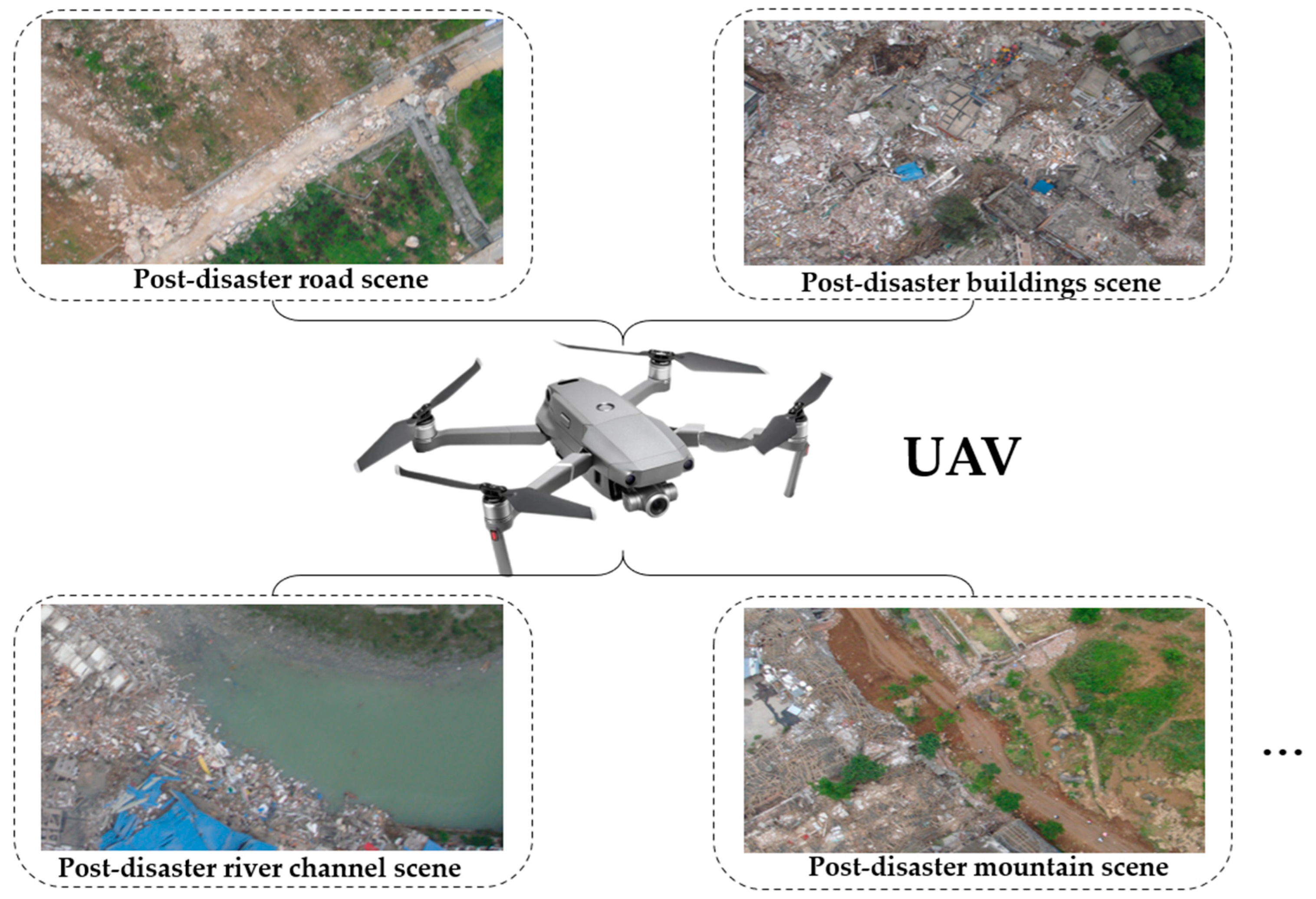

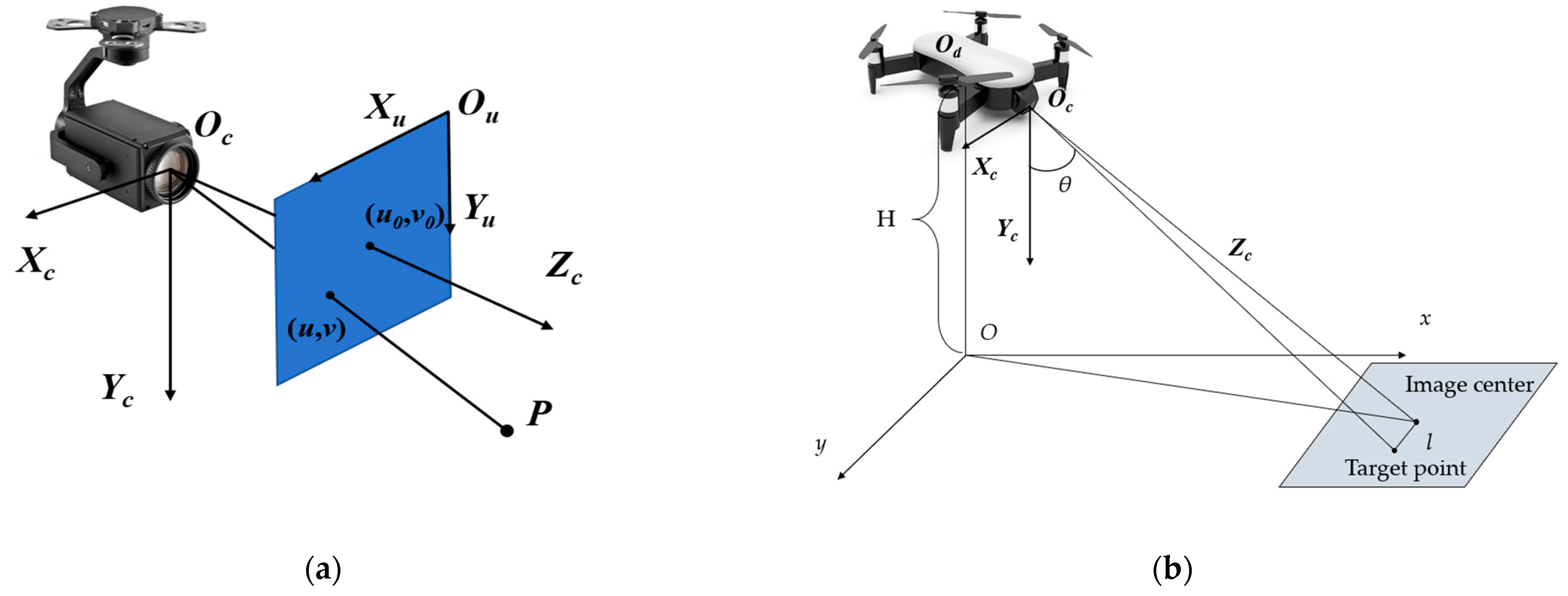
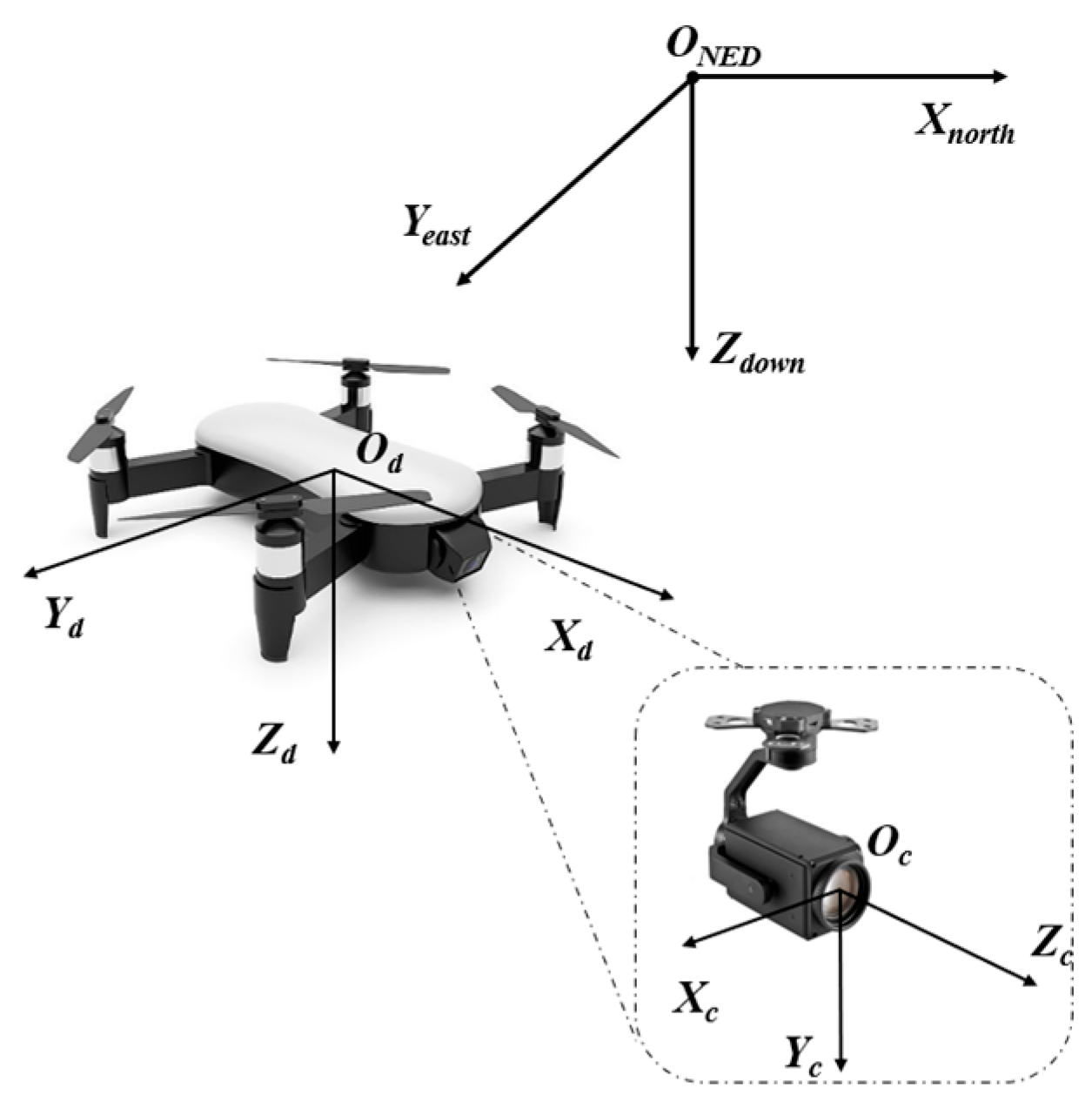

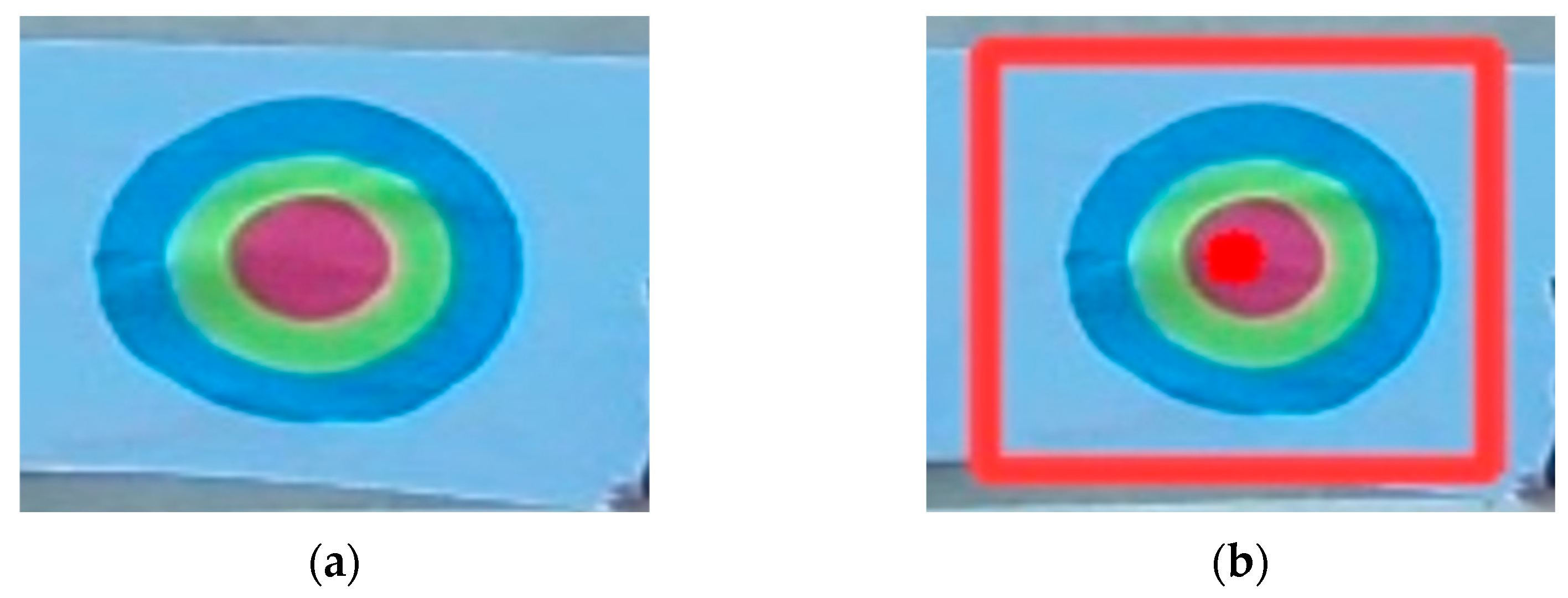















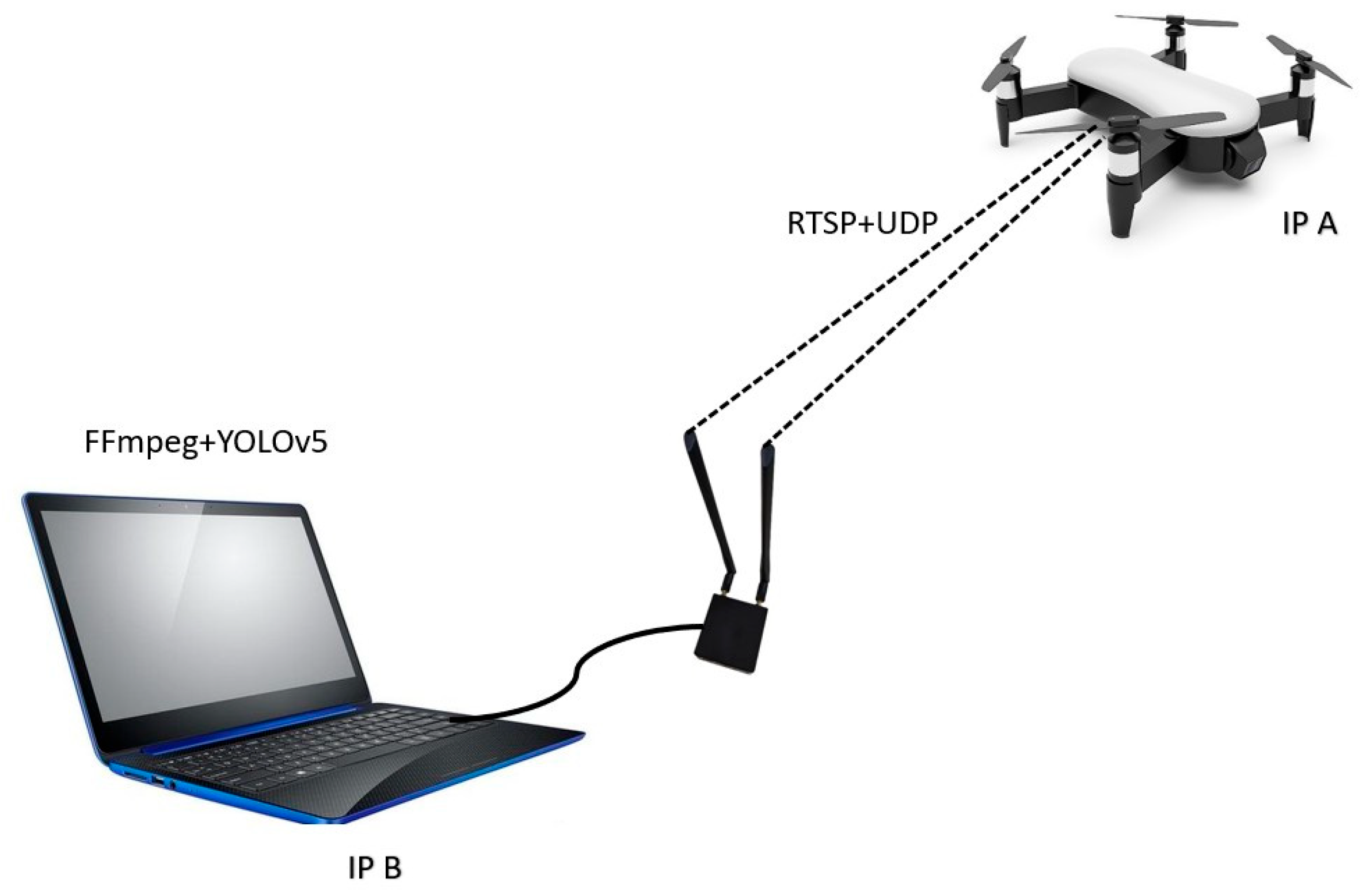
| Equipment Category | Key Parameters | Specification |
|---|---|---|
| UAV Platform | Place of production | China |
| Maximum takeoff weight | 1050.0 g | |
| Dimensions (unfolded state) | Length: 347.5 mm Width: 283 mm Height: 139.6 mm | |
| Maximum tilt angle | 30° (normal mode) 35° (sport mode) | |
| Visible Light Camera | Equivalent focal length | 24 mm |
| Image sensor | 4/3 CMOS, effective pixels of 20 million | |
| Video encoding and resolution | FHD: 1920 × 1080 @30fps | |
| Pan–Tilt–Zoom (PTZ) | Stabilizing system | Three axis mechanical pan tilt (pitch, roll, translation) |
| Scope of structural design | Pitch: −135° to 45° Roll: −45° to 45° Translation: −27° to 27° |
| 25.0 m | 35.0 m | |
|---|---|---|
| Calculation Results | ||
| 45° | [−5.5404, −3.4826, 35.332] | [−0.60908, 7.9567, 49.541] |
| [0.26019, −0.2642, 35.051] | [−4.6808, 0.64331, 49.907] | |
| [−10,476, −0.12113, 36.232] | [15.173, 10.293, 49.443] | |
| 60° | [−5.3975, 1.0858, 28.894] | [−3.8445, 3.0647, 40.426] |
| [−5.2994, −3.4942, 28.832] | [−4.2012, 0.16566, 40.317] | |
| [2.686, −6.8897, 29.436] | [4.9915, −4.0311, 40.344] | |
| 90° | [−12.737, −4.1114, 26.074] | [−0.69363, −4.6767, 35.437] |
| [−0.56355, −4.2656, 25.303] | [7.363, −4.9165, 35.961] | |
| [6.6554, −4.2827, 25.881] | [−12.326, −4.5808, 36.209] | |
| 25.0 m | 35.0 m | |||
|---|---|---|---|---|
| Results Without Our Model Application | Results with Our Model Application | Results Without Our Model Application | Results with Our Model Application | |
| 45° | [6.342, −8.2353, 35.832] | [11.164, −8.2575, 35.488] | [5.996, 5.0341, 49.312] | [11.861, 5.3454, 48.935] |
| [12.471, −5.803, 34.829] | [17.154, −5.661, 34.309] | [4.0174, −2.8724, 49.827] | [8.5817, −2.3317, 49.545] | |
| [1.3376, −4.5432, 37.28] | [6.7635, −4.4036, 36.728] | [20.1921, 8.9622, 47.9835] | [27.279, 9.2576, 47.705] | |
| 60° | [0.2186, 0.134, 28.963] | [4.0158, −0.14141, 28.3] | [5.922, 2.0261, 40.3942] | [11.612, 2.268, 39.904] |
| [0.2313, −4.8328, 29.3432] | [4.2791, −4.67, 28.939] | [5.7361, −1.233, 40.562] | [11.177, −0.59898, 40.255] | |
| [7.684, −7.6182, 29.937] | [12.38, −7.7238, 29.523] | [14.8327, −5.5344, 39.8637] | [20.168, −5.1525, 39.513] | |
| 90° | [−3.0042, −7.9827, 27.951] | [2.0976, −8.0268, 27.065] | [7.523, −8.143, 35.633] | [12.131, −7.9453, 35.13] |
| [10.173, −9.6482, 25.015] | [13.947, −9.4482, 24.661] | [15.053, −7.698, 34.9545] | [20.151, −7.3715, 34.565] | |
| [15.727, −9.982, 24.042] | [20.982, −10.217, 23.234] | [−4.2875, −9.4011, 36.612] | [0.57846, −9.0224, 35.958] | |
| 25.0 m | 35.0 m | |||||||
|---|---|---|---|---|---|---|---|---|
| No Model Results | Affine Transformation Compensation Results | SDCM Compensation Results | Actual Latitude and Longitude | No Model Results | Affine Transformation Compensation Results | SDCM Compensation Results | Actual Latitude and Longitude | |
| 45° | 116.3490167 39.99119549 | 116.34899329 39.99123152 | 116.34895816 39.99128555 | 116.349006 39.991445 | 116.3492011 39.99121515 | 116.34917768 39.99125118 | 116.34914256 39.99130521 | 116.349058 39.991382 |
| 116.34904681 39.99124943 | 116.34902339 39.99128546 | 116.34898826 39.99133949 | 116.349076 39.991425 | 116.3491113 39.9911854 | 116.34908788 39.99122142 | 116.34905275 39.99127546 | 116.349029 39.991452 | |
| 116.34906213 39.99115586 | 116.34903871 39.99119188 | 116.34900358 39.99124592 | 116.348974 39.991406 | 116.3492463 39.9913540 | 116.34922297 39.9913901 | 116.34918784 39.99144414 | 116.349205 39.991381 | |
| 60° | 116.349103 39.99113243 | 116.34907958 39.99116846 | 116.34904445 39.99122249 | 116.349011 39.991241 | 116.3491718 39.9912095 | 116.34914842 39.9912456 | 116.34911329 39.99129964 | 116.349029 39.991303 |
| 116.34904998 39.9911349 | 116.34902656 39.99117092 | 116.34899144 39.99122496 | 116.349014 39.991321 | 116.3491383 39.9912053 | 116.34911495 39.99124134 | 116.34907982 39.99129537 | 116.3490267 39.991328 | |
| 116.34901438 39.99120793 | 116.34899096 39.99124395 | 116.34895583 39.99129799 | 116.34911 39.991385 | 116.3490836 39.9912857 | 116.3490602 39.9913218 | 116.34902507 39.99137583 | 116.34911 39.991385 | |
| 90° | 116.3490173 39.99111383 | 116.34899389 39.99114986 | 116.34895876 39.9912039 | 116.348949 39.991217 | 116.3490465 39.9912165 | 116.34902317 39.99125261 | 116.34898805 39.99130665 | 116.349068 39.99119 |
| 116.34900007 39.99122055 | 116.34897665 39.99125658 | 116.34894153 39.99131062 | 116.349091 39.991235 | 116.3490530 39.991288 | 116.34902961 39.99132483 | 116.34899449 39.99137887 | 116.349133 39.99122 | |
| 116.34899072 39.99128391 | 116.3489673 39.99131994 | 116.34893217 39.99137397 | 116.349161 39.991223 | 116.3490343 39.99111254 | 116.34901096 39.99114856 | 116.34897583 39.9912026 | 116.348949 39.991217 | |
| Model | MAE (m) | RMSE (m) | SD (m) | Accuracy Improvement Rate (%) | 95% CI for MAE (m) |
|---|---|---|---|---|---|
| Baseline | 16.025794 | 17.382022 | 6.731166 | / | (12.581419459902484, 19.47016840857082) |
| Affine | 14.022461 | 15.195763 | 5.855065 | 12.500676 | (11.02639273423576, 17.018530092113902) |
| SDCM | 12.201270 | 13.903402 | 6.665853 | 23.864800 | (8.790316925975512, 15.612223694219042) |
| Filter | Time/s | MAE | RMSE | NRMSE | SNR | Noise_Reduction | Smoothness |
|---|---|---|---|---|---|---|---|
| MovingAvg | 0 | 0.197011 | 0.500602 | 5006019311 | 2.046291 | 0.094376 | 0.216332 |
| BasicPF | 8.47 × 10−5 | 0.508139 | 0.650017 | 6500172269 | −3.05589 | −0.21675 | 0.129045 |
| BlockIEKF | 0.002897 | 0.217213 | 0.307571 | 3075708545 | 3.141993 | 0.074173 | 0.101011 |
| Kalman | 0.00388 | 0.159254 | 0.208941 | 2089408303 | 6.58 | 0.132133 | 0.013727 |
| 25.0 m | 35.0 m | |||
|---|---|---|---|---|
| Results Calculated by Coordinate System Rz-y-x | Results Calculated by Coordinate System Ry-x-z | Results Calculated by Coordinate System Rz-y-x | Results Calculated by Coordinate System Ry-x-z | |
| 45° | 116.34895816 39.99128555 | 116.3489493 39.99128555 | 116.34914256 39.99130521 | 116.3491466 39.99130282 |
| 116.34898826 39.99133949 | 116.3489797 39.99133949 | 116.34905275 39.99127546 | 116.3490567 39.99127329 | |
| 116.34900358 39.99124592 | 116.3489944 39.99124591 | 116.34918784 39.99144414 | 116.3491924 39.99144168 | |
| 60° | 116.34904445 39.99122249 | 116.3490443 39.99122117 | 116.34911329 39.99129964 | 116.3491106 39.99130058 |
| 116.34899144 39.99122496 | 116.3489913 39.99122354 | 116.34907982 39.99129537 | 116.349077 39.99129666 | |
| 116.34895583 39.99129799 | 116.3489556 39.9912965 | 116.34902507 39.99137583 | 116.3490237 39.99137764 | |
| 90° | 116.34895876 39.9912039 | 116.348952 39.99120389 | 116.34898805 39.99130665 | 116.348991 39.99130526 |
| 116.34894153 39.99131062 | 116.3489354 39.99131061 | 116.34899449 39.99137887 | 116.3489977 39.99137749 | |
| 116.34893217 39.99137397 | 116.3489264 39.99137397 | 116.34897583 39.9912026 | 116.3489784 39.99120121 | |
Disclaimer/Publisher’s Note: The statements, opinions and data contained in all publications are solely those of the individual author(s) and contributor(s) and not of MDPI and/or the editor(s). MDPI and/or the editor(s) disclaim responsibility for any injury to people or property resulting from any ideas, methods, instructions or products referred to in the content. |
© 2025 by the authors. Licensee MDPI, Basel, Switzerland. This article is an open access article distributed under the terms and conditions of the Creative Commons Attribution (CC BY) license (https://creativecommons.org/licenses/by/4.0/).
Share and Cite
Zheng, Z.; Liu, H.; Ye, Z.; Wang, M.; Li, H.; Lu, X.; Li, Q. Target Localization of a Quadrotor UAV with Multi-Level Coordinate System Transformation Based on Monocular Camera Position Compensation. Electronics 2025, 14, 4371. https://doi.org/10.3390/electronics14224371
Zheng Z, Liu H, Ye Z, Wang M, Li H, Lu X, Li Q. Target Localization of a Quadrotor UAV with Multi-Level Coordinate System Transformation Based on Monocular Camera Position Compensation. Electronics. 2025; 14(22):4371. https://doi.org/10.3390/electronics14224371
Chicago/Turabian StyleZheng, Zhefu, Haoting Liu, Zhipeng Ye, Mengmeng Wang, Haiguang Li, Xiaofei Lu, and Qing Li. 2025. "Target Localization of a Quadrotor UAV with Multi-Level Coordinate System Transformation Based on Monocular Camera Position Compensation" Electronics 14, no. 22: 4371. https://doi.org/10.3390/electronics14224371
APA StyleZheng, Z., Liu, H., Ye, Z., Wang, M., Li, H., Lu, X., & Li, Q. (2025). Target Localization of a Quadrotor UAV with Multi-Level Coordinate System Transformation Based on Monocular Camera Position Compensation. Electronics, 14(22), 4371. https://doi.org/10.3390/electronics14224371






